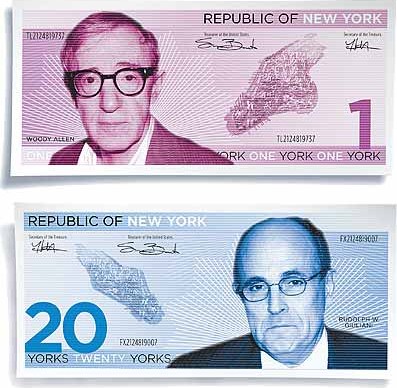
About Andrew Cusack
 Writer, web designer, etc.; born in New York; educated in Argentina, Scotland, and South Africa; now based in London.
Writer, web designer, etc.; born in New York; educated in Argentina, Scotland, and South Africa; now based in London. read more
News
Blogs
Reviews & Periodicals
Arts & Design
World
France
Mitteleuropa
Knickerbockers
Argentina
The Levant
Africa
Cape of Good Hope
Netherlands
Scandinavia
Québec
India
Muscovy
Germany
Academica
New York Currency

When New York magazine speculated on the prospects of an independent New York they postulated Woody Allen gracing a “1 York” note with Rudolph Guliani on the “20 York” note. In Caledonia they’re used to dealing with many different varieties of banknotes. In Scotland alone there are three different institutions authorised ot print currency: the Royal Bank of Scotland, the Bank of Scotland, and the Clydesdale Bank. Northern Ireland, meanwhile, has four: the Bank of Ireland, Ulster Bank, Northern Bank, and First Trust Bank. England and Wales, on the other hand, have but the Bank of England to issue legal tender, that institution having been granted a monopoly so to do in 1921. [More on British banknotes]
Nonetheless, this got me to thinking who and what I would put on New York bank notes if we had them. First of all, none of this “York” business; dollars they are and dollars they would remain in my land of fancy. Anyhow, here’s what I generally came up with:
Value — Front / Back
$1 — Saint Nicholas / Dutch, English, British, State, and American flags
$5 — Peter Stuyvesant / The Stadt Huis (Dutch Town Hall)
$10 — James II / Scene of Colonial New York
$20 — DeWitt Clinton / Map of Erie Canal and the Grid Plan
$50 — Alexander Hamilton / Scenes of Trade and Commerce
$100 — Theodore Roosevelt / The Dewey Arch
Penny (1¢) — Saint Nicholas / Coat of Arms of New York
Nickel (5¢) — Henry Hudson / Coat of Arms of New York
Dime (10¢) — Washington Irving / Coat of Arms of New York
Quarter (25¢) — John Jay / Coat of Arms of New York
St. Nicholas, of course, I’m quite fond of and is the patron saint of New York and so ought to be represented prominently. Peter Stuyvesant was the first leader to knock the place into shape. New York was named after James II while he was still just the Duke of York. He was also the last reigning Catholic king of England. DeWitt Clinton was the genius behind the Erie Canal and a major proponent of the 1811 Commissioners’ Plan which laid out the majority of Manhattan according to a grid plan. Alexander Hamilton shaped the modern American system of trade and commerce, founded the Bank of New York, and the New York Post, both of which are still around today. And Theodore Roosevelt was Theodore Roosevelt.
Henry Hudson was the English explorer working for the Dutch who explored New York harbour and eponymously named the Empire State’s great river. Washington Irving is arguably the greatest New York author; he is certainly at least the first great New York author and the first American to make his living entirely through literature. Many of his tales are the foundational myths of New York. John Jay was the first Chief Justice of the United States and before that was an important opponent of the radical tendency during the Revolution and also one of the framers of the U.S. Constitution. The Coat of Arms of New York (the shield of which permanently graces the top of this webpage) could form a uniform reverse for coinage, like the Queen’s head on British coins.
Suggestions, objections, and comments welcome.
Previously: Res Publica Nova Eboraci
Search
Instagram: @andcusack
Click here for my Instagram photos.Most Recent Posts
- Bicycle Rack April 29, 2024
- Burns Tower April 19, 2024
- Patrick in Parliament March 18, 2024
- Articles of Note: 13 March 2024 March 13, 2024
- Cambridge March 9, 2024
Most Recent Comments
Book Wishlist
Monthly Archives
Categories



Hear, hear!
But no FDR? (*Choke*!)